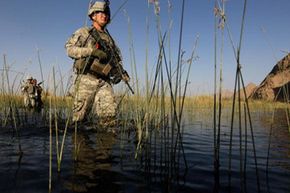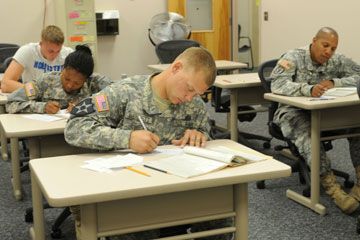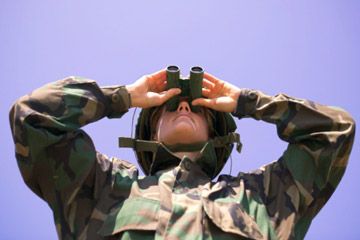The Army's Non-Commissioned Officer Education System (NCOES) provides the courses that NCOs must complete before they advance to the next rank. The Professional Development Ribbon is awarded for completing the first school, the Warrior Leader Course. There is only one Professional Development Ribbon. It does not come with a medal. The ribbon, established in 1981, has vertical stripes in green and yellow, the colors of chevrons (V-shaped insignia) worn by NCOs, and blue, indicating support of the United States.
NCOs who complete higher-level courses are awarded numerals, 2 through 4, to pin on their Professional Development Ribbon. The numeral on a NCO's ribbon will indicate the highest level NCOES course completed. The highest is 4.
Late in 2009, the Army began overhauling its education system for enlisted soldiers. The changes included new, mandatory online Structured Self-Development courses (SSD) for all enlisted soldiers throughout their Army careers. NCOs must complete online SSD courses as prerequisites for attending Professional Development Courses. They're designed to be a bridge between practical experience and education. Changes also were made in the five Professional Development Courses for NCO advancement. Emphasis is more on education for leadership and self-confidence than on drills and specific training.
Some of the courses were renamed.
Here are the Professional Development Courses:
- Warrior Leader Course. This is the first level, formerly known as the Primary Leadership Development Course. This course lasts 15 days and is taught at a number of military installations across the country. It focuses on leadership and team-building. Students earn the Professional Development Ribbon upon completion.
- Advanced Leader Course. This was formerly known as the Basic Noncommissioned Officers Course. This course unfolds in two phases. There's a Web-based core class for all students, focusing on training at the squad and platoon levels. The second is specific for the NCO's Military Occupational Specialty (MOS) and taught at the school for that specialty. Length varies according to specialty, but the course doesn't run more than eight weeks. The number 2 is added to the NCO ribbon upon completion.
- Senior Leader Course. This used to be the Advanced Noncommissioned Officers Course. It's conducted at the school for that chosen MOS. The course length varies and includes parts of the former resident First Sergeants Course. Upon completion, the number 3 is added to the ribbon.
- Sergeants Major Course. This advanced course -- or equivalent training approved by Headquarters, Department of the Army -- is taught at the U.S. Army Sergeants Major Academy at Fort Bliss, Texas. The class lasts nine months, or two years if the NCO is not a resident at Fort Bliss. Once this class is completed, the number 4 -- the highest possible -- is added to the ribbon.
Keep reading for lots more information about military careers.


